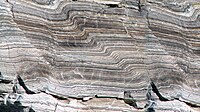
Photo from wikipedia
Abstract Atomic scale deformation mechanisms of Ti single- and bicrystals subjected to scratch testing were studied experimentally and using molecular dynamics simulation. The numerical model explicitly considers the crystallographic orientation… Click to show full abstract
Abstract Atomic scale deformation mechanisms of Ti single- and bicrystals subjected to scratch testing were studied experimentally and using molecular dynamics simulation. The numerical model explicitly considers the crystallographic orientation of Ti crystallites experimentally determined from EBSD analysis. The stage character of the evolution of dislocation structure in the Ti crystallites under loading was revealed that resulted from fragmentation of the material in the scratch groove. When the direction of easy dislocation glide is close to the scratching direction, the stages of generation and movement of dislocations alternate with the stages of dislocation pinning. It was found experimentally that the initially softer grain was characterized by a shallower residual scratch depth than the originally harder one. MD simulation revealed that the fragmentation is an origin of the observed disagreement between the residual scratch depth and the initial hardness of Ti grains with different crystallographic orientations. Grain boundaries were shown not only to be barriers for dislocation glide but also to favor the development of rotational deformation and further fragmentation of the material in the scratch groove.
Journal Title: Applied Surface Science
Year Published: 2019
Link to full text (if available)
Share on Social Media: Sign Up to like & get
recommendations!